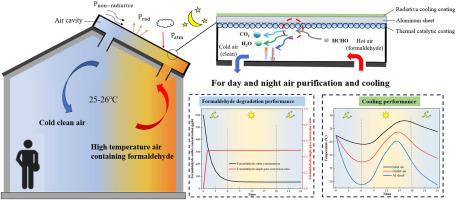A novel hybrid low-temperature thermal catalysis and radiative sky cooling system for day and night air purification and cooling
IF 9.4
1区 工程技术
Q1 ENERGY & FUELS
引用次数: 0
Abstract
Thermal catalytic oxidation is an air purification technology that can efficiently and stably degrade volatile organic compounds. However, using thermal catalysis to purify indoor air in the summer can cause problems of indoor overheating. Radiative sky cooling is a passive cooling method that dissipates heat through reflection and radiation, which can provide sub-ambient cooling during day and night. In this study, a novel hybrid low-temperature thermal catalysis and radiative sky cooling system for day and night air purification and cooling was proposed, which combined thermal catalysis with radiative sky cooling, and used low-temperature driven thermal catalysts to solve the problem of indoor overheating in summer. A numerical model of the hybrid system was established to simulate the formaldehyde degradation and cooling performance of the system under different operating conditions. The results show that under summer conditions with an average daily temperature of 35 °C and humidity levels between 70 % and 80 %, the system produced a total of 665.29 m³/m2 of clean air after running for an entire day. The average single-pass conversion rate of formaldehyde was 0.46, and the maximum temperature difference between indoor and outdoor air was 5 °C. This provides guidance for the integration of the hybrid system with buildings.

用于昼夜空气净化和冷却的新型混合低温热催化和辐射天空冷却系统
热催化氧化技术是一种能够高效、稳定地降解挥发性有机化合物的空气净化技术。然而,在夏季使用热催化技术净化室内空气会造成室内过热的问题。辐射天冷是一种通过反射和辐射散热的被动冷却方法,可在白天和夜间提供亚环境冷却。本研究提出了一种用于昼夜空气净化和冷却的新型低温热催化与辐射天冷混合系统,该系统将热催化与辐射天冷相结合,利用低温驱动热催化剂来解决夏季室内过热问题。建立了混合系统的数值模型,模拟了系统在不同运行条件下的甲醛降解和降温性能。结果表明,在日平均气温 35 ℃、湿度介于 70 % 至 80 % 之间的夏季条件下,该系统全天运行后总共产生了 665.29 立方米/平方米的洁净空气。甲醛的平均单次转化率为 0.46,室内外空气的最大温差为 5 °C。这为混合系统与建筑物的整合提供了指导。
本文章由计算机程序翻译,如有差异,请以英文原文为准。
求助全文
约1分钟内获得全文
求助全文
来源期刊

Energy
工程技术-能源与燃料
CiteScore
15.30
自引率
14.40%
发文量
0
审稿时长
14.2 weeks
期刊介绍:
Energy is a multidisciplinary, international journal that publishes research and analysis in the field of energy engineering. Our aim is to become a leading peer-reviewed platform and a trusted source of information for energy-related topics.
The journal covers a range of areas including mechanical engineering, thermal sciences, and energy analysis. We are particularly interested in research on energy modelling, prediction, integrated energy systems, planning, and management.
Additionally, we welcome papers on energy conservation, efficiency, biomass and bioenergy, renewable energy, electricity supply and demand, energy storage, buildings, and economic and policy issues. These topics should align with our broader multidisciplinary focus.
 求助内容:
求助内容: 应助结果提醒方式:
应助结果提醒方式:


